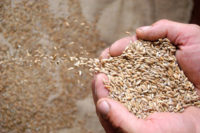U.S. Panel Urges New School Nutrition Standards
The Institute of Medicine committee recommends bans on some snacks sold in schools.
A report issued in April by the U.S. Institute of Medicine recommends that the government ban soft drinks, sugary snacks and some other snack foods from schools as part of an effort to combat the growing problem of childhood obesity.
The report, developed by a special committee established by the IOM and requested by Congress, says that those products should be replaced with healthier foods such as fruits, vegetables and low-fat dairy products.
In place of potato chips, chocolate bars and other popular snacks, the report recommends that schools sell options such as apples, carrot sticks, raisins, low-sugar cereals, whole-grain tortilla chips, granola bars and nonfat yogurt with no more than 30 g. of added sugar.
The proposed guidelines also urge limiting the content of snacks and drinks to no more than 200 calories per portion and switching to items that contain no trans fats, lower levels of sugar and sodium, and no more than 35% of calories from fat, less than 20% from saturated fat. It also recommends eliminating sports drinks, soft drinks and caffeinated drinks, and calls on schools to provide free, safe drinking water or give students the opportunity to purchase nonfat or low-fat milk, or limited amounts of 100% juice.
If the guidelines were adopted, high schools could sell snacks such as baked potato chips, whole wheat pretzels, seltzer water or caffeine-free diet soda after school hours.
“Research has shown that the school environment has a vital role in shaping children’s health behaviors,” the study explains. “The rise in obesity over the past 2-3 decades has been accompanied by an increase in the number of alternative food options available on school campuses.”
These “competitive foods,” the report adds, are vying with the traditional breakfast and lunches offered through federally subsidized school nutrition programs.
“The foods and beverages available during and after school can contribute a number of calories to their total daily consumption,” the report states.
After the report was issued, Sen. Tom Harkin (D-Iowa), who sponsored the Child Nutrition Promotion and School Lunch Protection Act with Sen. Lisa Murkowski (R-Alaska), suggested that the recommendations might be included in this year’s Farm Bill, now being developed in Congress.
Alliance Guidelines
The Snack Food Association has issued a press release expressing support for the conclusion that “action needs to be taken in the nation’s public schools to combat childhood obesity.” However, the SFA says a voluntary approach with nutrition guidelines developed by the Alliance for a Healthier Generation, which already are being implemented, will be a more effective way to achieve the same goals. (See the President’s Letter.)
“Clearly, the science base for this report needs to be evaluated carefully because it is likely to be used as the basis for legislation,” cautions Lisa Katic, SFA nutritionist and health policy advisor.
Katic points out that the industry already is working to comply with the “gold standard” voluntary guidelines established by the alliance.
“Very real changes are being made,” she says. “These companies should be commended, not told, ‘well, now, we need you to do something more.’”
“The food industry has a very important role to play in helping to improve the health and fitness levels of adolescents and young children,” says Jim McCarthy, SFA president and CEO. “While we all agree there is no single solution to combat obesity and that no one food should be singled out to blame for this very complex problem, the SFA understands the nutritional challenges faced in today’s school environment.”
Since the alliance’s guidelines were launched last year, SFA member companies have released new nutritious snack products that are formulated to meet or exceed those standards.
“Our members will continue to develop new ways to provide better-for-you snack options and work with the alliance to implement their guidelines in schools,” McCarthy says.
Guiding Principles
According to the IOM report, its recommendations were based on the following “guiding principles.”
The present and future health and well-being of school-age children are affected profoundly by dietary intake and the maintenance of a healthy weight.
Schools contribute to current and life-long health and dietary patterns and are uniquely positioned to model and reinforce healthful eating behaviors in partnership with parents, teachers, and the broader community.
Because all foods and beverages available on the school campus represent significant caloric intake, they should be designed to meet nutritional standards.
Foods and beverages have health effects beyond those related to vitamins, minerals and other known individual components.
Implementation of nutrition standards for foods and beverages offered in schools will likely require clear policies; technical and financial support; a monitoring, enforcement and evaluation program; and new food and beverage products.
The federally reimbursable school nutrition programs will be the primary source of foods and beverages offered at school.
All foods and beverages offered on the school campus will contribute to an overall healthful eating environment.
Nutrition standards will be established for foods and beverages offered outside the federally reimbursable school nutrition programs.
The recommended nutrition standards will be based on the Dietary Guidelines for Americans, with consideration given to other relevant science-based resources.
The nutrition standards will apply to foods and beverages offered to all school-age children (generally ages 4 through 18 years), with consideration given to the developmental differences between children in elementary, middle and high schools.





